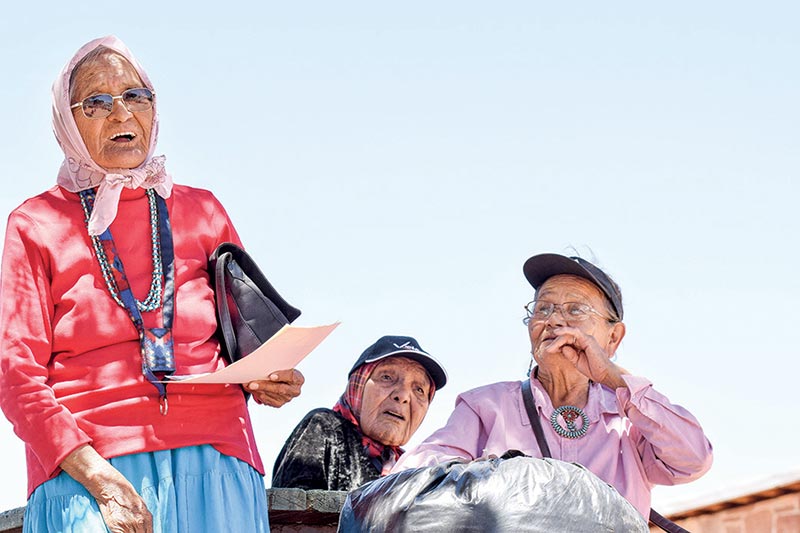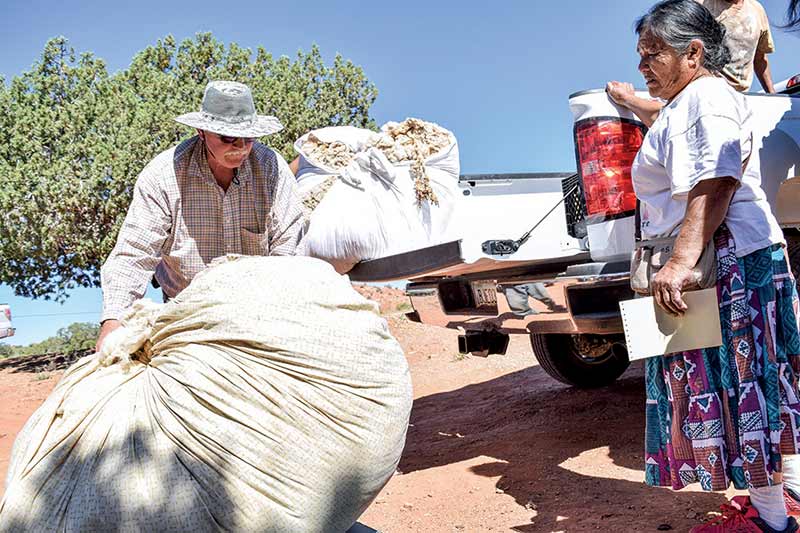
A way of life expressed through wool and mohair buys

Navajo Times | Krista Allen Florence Neztsosie, left, Evelyn Slick, and Susan Tate, right, wait in the shade during high temperatures on June 16 in Kaibeto, Arizona. The women each sold bags of fiber to fleece buyers.

Navajo Times | Krista Allen
A seller looks on as Stanley Strode, wool manager at Mid-States Wool Growers Cooperative Association in Canal Winchester, Ohio, unloads wool wrapped in a sheet June 16 in Kaibeto, Arizona.
KAIBETO, Ariz.
It was a sweltering morning but dozens of people last Friday waited in a line to sell raw sheep and goat fleece to buyers from the eastern U.S.
Some people even waited for several hours.
Florence Neztsosie, 77, said she could not deal with the heat so she got out of the passenger side of her truck and strolled around where transactions were being made with Tooh Dine’é (Anglo) buyers such as Peter Hagerty, Stanley Strode, and Teddy Varndell – all whom are in the mohair and wool industry.
So much has changed in a short period of time, said Neztsosie, from Naatsis’áán-Rainbow City, Utah, where she grew up. She herded sheep, wove rugs, and helped her late parents with household chores. She spoke in Navajo saying it is striking to see how the mohair- and wool-buying scene has changed since the trading post era.
“Long ago people sold raw fleece to Navajo traders,” Neztsosie recalled. “My family raised sheep and goats for profit, and it was our primary source of income.”
Neztsosie continues to raise sheep and goats for profit. Not only did she sell some raw fleece to the eastern buyers but also to Susan Tate, a weaver from Ts’ahbiikin, Arizona, for $12.
The longtime friends chatted and laughed with each other as they watched vehicles pull up to a floor scale where one of the buyers would examine the bags of fleece, then either purchase it or not.
Neztsosie and Tate watched as buyers gave the OK to a group of brawny young Diné men whose job was to unload the hefty bags from a seller’s truck, weigh them, and load them onto a semi-trailer.
Tate, 76, said in Navajo that she also raises sheep and goats for profit and that she was in search of black raw fleece that day for a rug she is weaving.
Fortunately, Neztsosie was selling black fibers, said Tate, who also sold raw fleece to the eastern buyers.
View a photo gallery
Click on any photo to launch the gallery







Varndell, a mohair buyer from Chicago, says Western Navajo is where the raw fleece purchase truly begins.
“No offense to the eastern Navajo Nation,” he said. “But this is where it all begins.”
“There are two very distinctly different groups from our vantage point, it seems, on the Navajo Nation,” explained Hagerty, co-founder of Peace Fleece in Porter, Maine. “We find more fine wool animals in the eastern side (such as) Rambouillet which we can make yarns out of that are much softer.”
Western Navajo, Hagerty says, produces European wool and a mixture of others such as Navajo Churro.
“They (Western Navajo) still have Navajo Churro and European breeds,” Hagerty said. “My sense is that the interest in Churro … is based in weaving, which is strong on Black Mesa and stronger in this region, but less so down toward Thoreau, Crownpoint, and Shiprock. But we benefit from both groups.”
Hagerty and Strode, a wool manager at Mid-States Wool Growers Cooperative Association in Canal Winchester, Ohio, say they pay the most money for Rambouillet and Merino wools because their markets utilize these types of fibers the most.
Hagerty and Strode, however, have not been able to purchase Churro because they do not have a market for it.
Varndell says he is currently working on developing a market for the Churro wool in Europe.
“But right now, we don’t have enough to pay these people a decent price,” Hagerty explained. “We just don’t buy it because we don’t want to humiliate them by having them coming in with these beautiful fleeces and not being able to pay anything for it. But we’re working on that.”
The buyers say for them to consider Navajo wool high quality, it must have softness, strength, and length.
“It’s good strength when you pop that wool back and forth, and good length,” Hagerty said as he examined a piece of wool. “So for a sweater, it’s going to last 30 years instead of three years.”
The buyers say their businesses and products are now made almost exclusively from Navajo wool.
“What I find here (in the Navajo Nation) that’s so impressive is the richness of Navajo culture,” Hagerty said. “The pastoral lifestyle and the respect for elders – things that we Bilagáana have lost in our culture.”
He continued, “So hopefully Navajo children are looking at them and saying they respect their people, their grandparents, and that they want to do that.”
Jay Begay from Hard Rock, Arizona, who works for Varndell, says the annual wool and mohair buy defines Navajo culture and its history that can be only experienced at an event like this.
Throughout the years, Begay says he has seen the elders and children alike at wool- and mohair-buy events, many of them wearing their traditional outfits and who only speak Navajo.
“Our culture may disappear in another 30 years,” Begay said, as he took a small break from lifting heavy bags of fleece.
“These young men, they’re bilingual,” Hagerty said. “They’re all hard workers and they’re all an amazing example of what the future of youth on this Navajo Nation could be.”
The buyers said when they were in Piñon, Arizona, last year for the buy event they witnessed a happening at Bashas’ where people were cashing their wool checks.
“Some of us went down to buy some food at Bashas’ and we walked in,” Hagerty recalled. “We couldn’t get into the store because it was jammed. We went up to the security guy and asked what was going on and if there was a storm coming. He said no and that everybody’s cashing their wool checks and buying food.
“That was really cool!” Hagerty exclaimed. “So we can see within exactly the same day, within 24 hours, a direct impact on the Navajo economy.”
The buyers say they put more than $90,000 into the Navajo economy.
Grace Welch, 89, from Kaibeto, Arizona, sold wool and mohair fibers and received money that she says she will use to buy new shoes and new material for an outfit.
“My shoes are wearing out,” Welch said in Navajo.
Tate said she also received enough money to buy snacks and to fill her vehicle’s gas tank.
To read the full article, pick up your copy of the Navajo Times at your nearest newsstand Thursday mornings!
Are you a digital subscriber? Read the most recent three weeks of stories by logging in to your online account.








 Highway 264,
Highway 264, I-40, WB @ Winslow
I-40, WB @ Winslow